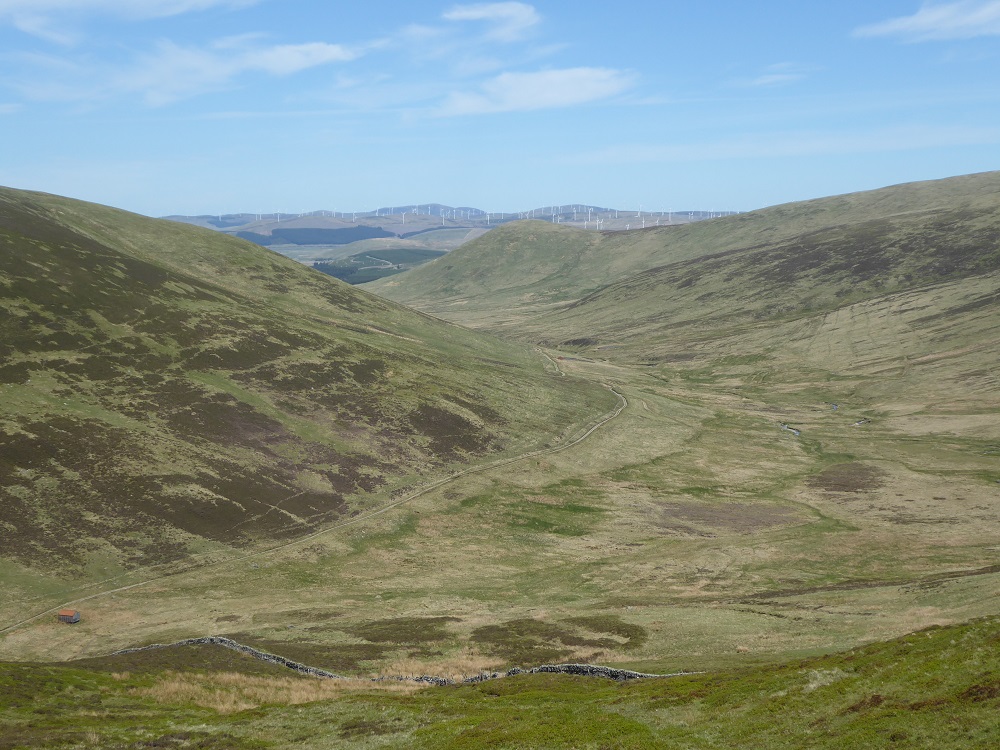
On Saturday, my partner and I drove 50 miles from Glasgow to go walking in the hills east of Durisdeer, off the A702 south of Abington. The decision to ignore the Scottish Government’s guidance to stay local and to go south was quite deliberate. I knew there would be far fewer people in the countryside than in Glasgow’s open spaces. I also reckoned there would be less traffic and far less hassle trying to find somewhere to park in Dumfries and the Borders than further north.
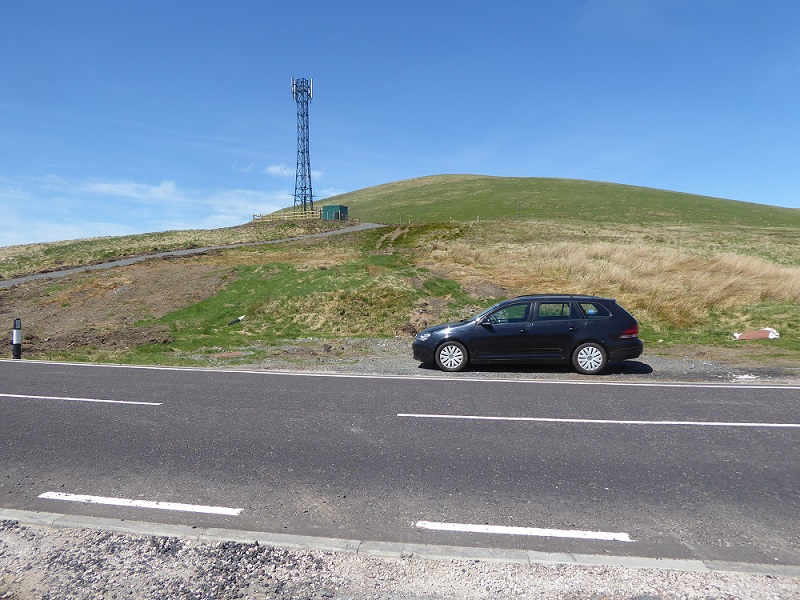
I was right about the parking, we saw just one blocked off layby by a village. There were plenty of places to pull safely off the road. We did so about 400m from the nearest house in order to avoid causing any unnecessary worry. Ours was the only car we saw parked in the glen all day. It’s only about 10km in length. A very safe place to go
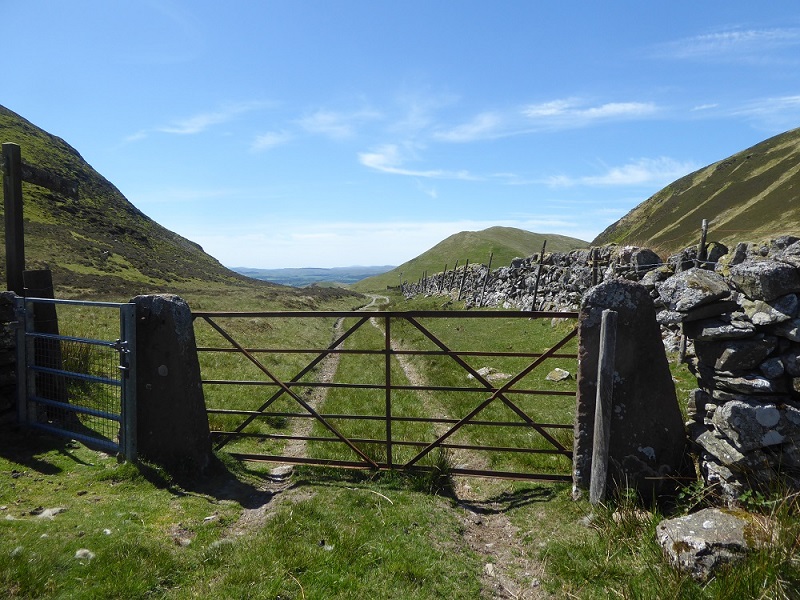
We went through three gates in six hours. I must confess, being a soap and water person, I had forgotten to buy hand sanitiser before going out. I’ll be better prepared next time but the scientific evidence suggests coronaviruses last for only a very short time in the sun.
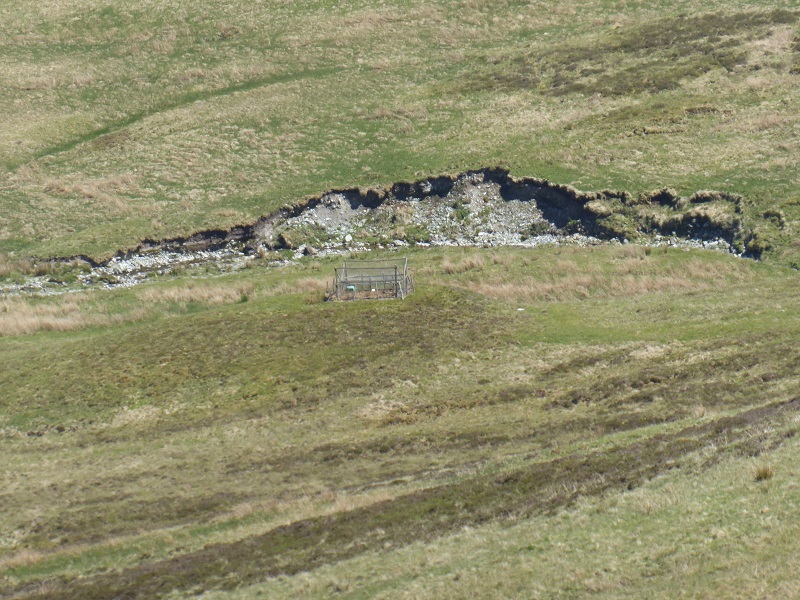 Walking up the Scaw’d Law we heard several gunshots. Despite binoculars we couldn’t see where the shooting was coming from. We saw a couple of Ladder Traps and it’s possible it was keepers shooting crows under the General License. I was concerned it might be raptors because the Leadhills Estate (see here) just to the north is a persecution hotspot. In the event we saw three hen harriers, four buzzards and a kestrel as well as mountain hare and lots of voles.
Walking up the Scaw’d Law we heard several gunshots. Despite binoculars we couldn’t see where the shooting was coming from. We saw a couple of Ladder Traps and it’s possible it was keepers shooting crows under the General License. I was concerned it might be raptors because the Leadhills Estate (see here) just to the north is a persecution hotspot. In the event we saw three hen harriers, four buzzards and a kestrel as well as mountain hare and lots of voles.
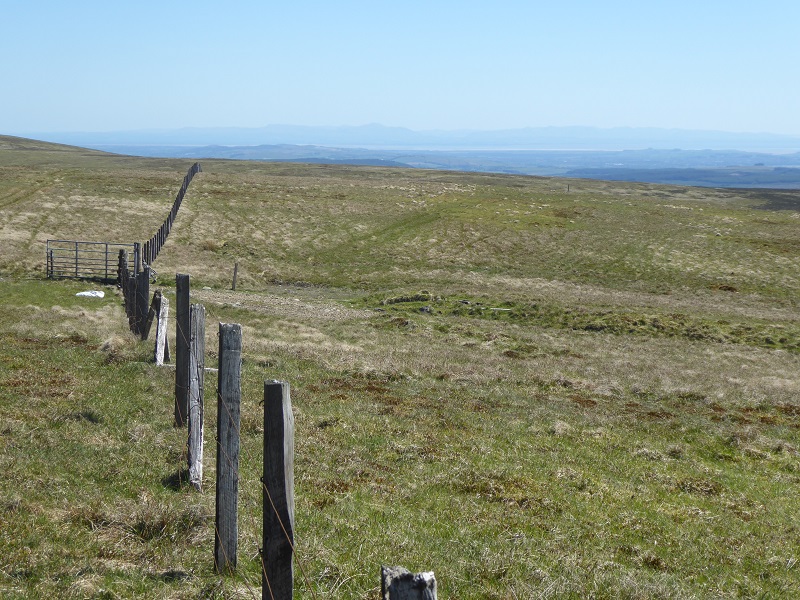
We also saw just two people all day, close to the summit of Scaw’d Law. They got to within 50m of us. There were no conceivable issues about how to keep apart from them, there was so much space.
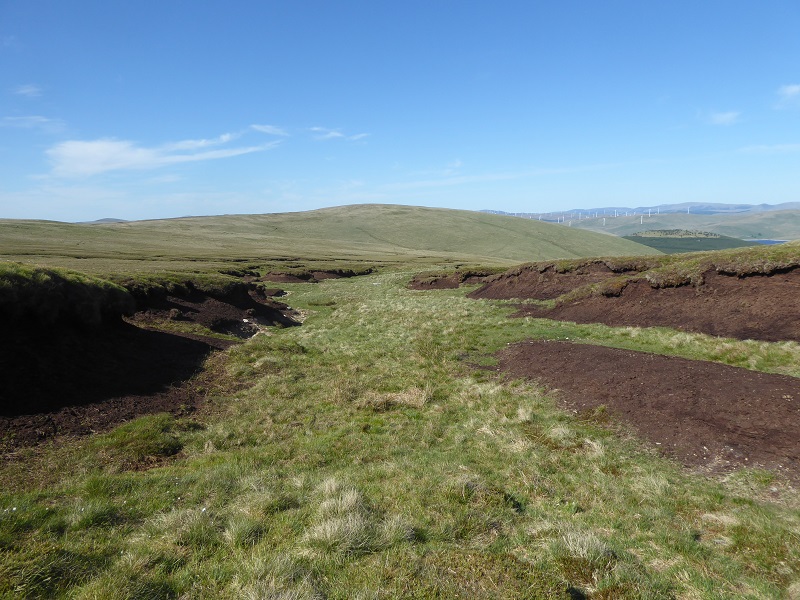
Much of Scotland is like this. As a country we are so lucky, we have hundreds of square miles of open space, some wild, some less wild, but all safe places for people to go in a pandemic. There has never been any justification for stopping people from going out to walk in our open spaces since the start of the corona crisis, and there certainly isn’t now. But still the Scottish Government and the countryside establishment urge us to “stay local”.
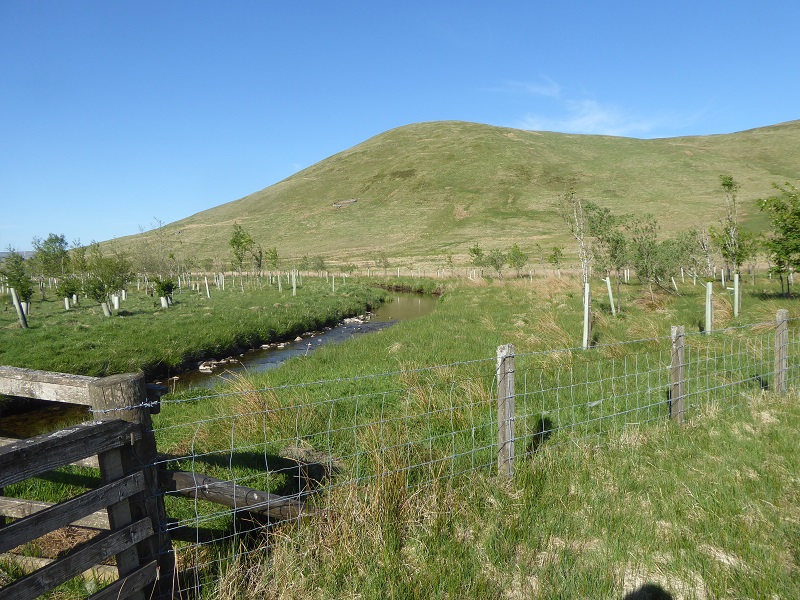
As I keep repeating, there is a missed opportunity here for outdoor recreation and the rural economy. There is no reason why self-catering accommodation (see here for sample of such accommodation around Leadhills), where households could stay self-contained and could avoid using local shops if asked, shouldn’t re-open again. That, and allowing people to leave their homes overnight to go wild camping or campervanning, would help people take full advantage of our countryside again instead of burning up fuel on day visits.
The contrast between the Borders and Glasgow
On Friday evening, the day the Restriction Regulations were relaxed, I went for my usual run in and around Pollok Park. As well as usual walkers, cyclists and runners, there were significantly more people enjoying sitting in the large grassy fields than I had seen to date, all well spaced. Perhaps it was the sunny evening, but making making it legal once again for people to sit outdoors would appear to have encouraged more people to go out. A positive development for people’s mental well-being.
It was, however, the first time since the Coronavirus lockdown that I have felt remotely uneasy in Pollok Park. Groups, mainly of young people , had congregated in a field by the river oppositePollok House and many were clearly enjoying paddling or jumping into the river in the heat. Few, however, were observing physical distancing and in the excitement some were not stepping aside when passing by others on the path. There was no sign of the police on the one occasion I have observed to date where their presence could have made a difference.
It’s too easy to judge. The groups could have been people who worked together in workplaces deemed “essential”, where there has been little physical distancing and some may have had the virus. We are in a strange situation where health staff, who are in close contact with colleagues on a daily basis at work, still commit a criminal offence if they meet each other in their homes. Doctors in relationships, living apart, a not uncommon occurrence, are still not supposed to see each other even if one of them has had the virus.
It’s also easy to overstate the risks. Most Covid-19 outbreaks, though until we have an effective contact tracing system we can’t be certain of this, now appear to be circulating among health and social care staff and others working in high risk places like distribution depots. If the young people hadn’t been working, the chances are none of them had the virus. Moreover, even if one of them had, there is relatively little likelihood of them spreading it by being closer than 2m contact outdoors. I was still, however, concerned but I don’t believe we should not be curtailing the civil liberties of the 90% of the population who are maintaining physical distancing as a matter of course.
We need to find other ways to encourage everyone to do the right thing. The police are one way but better is the influence of other people doing the right thing. On Sunday, I was re-assured that “group discipline”, if you can call it that, appeared to have been restored and that Stay Apart continues to be the social norm.
The Scottish Government’s advice to Stay Local and the closure of visitor hotspots
What Pollok Park illustrates in miniature is that while we need some management of visitor hotspots (encouraging the people in the field to spread out) we could allow other places – like almost everywhere in the Borders – to go unmanaged, if people were helped to disperse.
As more people have dared to leave their homes, this has increased the pressure on open spaces in settlements. That situation will get worse as the golf courses re-open. Many people in urban settlements the last few weeks have been exercising their rights of access on golf courses – I have a friend who during the lockdown has been exploring most of Glasgow’s finest. As the golf balls begin to fly again – a good thing – the ability to walk over golf course is going to become more difficult. That means, if people follow the Scottish Government’s advice to stay local, there will be more people will confined into less space.
Unfortunately, instead of helping people to disperse, the Scottish Government’s message of Stay Local and its endorsement of the continued closure of visitor facilities (see here), backed by almost all the countryside agencies, is concentrating people and creating problems rather than solving them.
As an example from the weekend, the continued closure of car parks around the cities may have deterred some people from visiting the countryside. However, it’s also forced those who have decided, quite rationally, to escape crowded settlements to park on road verges. This increases the chances of road traffic accidents, one of the very reasons used to justify the calls for people to stay away from the countryside (because of the demand accidents place on the NHS). Readers over the weekend reported to Parkswatch 30 cars parked along the A83 by the Cobbler, where Argyll and Bute have failed to re-open the car park, and similar problems along the coast in east Lothian. It appears our public authorities would far prefer the public to be crowded into places like Portobello beach rather than spread out in the countryside
Moreover, the continued closure of toilets, which I will cover in another post, will potentially create another public health disaster. By all accounts some of the beaches in England are now quite disgusting because of the continued closure of toilets. The same will be happening in parts of Scotland.
We need our Public Authorities to start helping visitors and stop seeing the answer to every potential problem, as epitomised by the Loch Lomond and Trossachs National Park, as being to ban people and shut facilities. The facilities in the LLTNP, which should have been the first to re-open in Scotland, will on their past record be the last to do so.
Meantime, people should use their common sense. Whatever the risks of going for a walk in the city or from your village, if you can negotiate the blocked off car parks you are almost certainly far safer if you venture out into the countryside.
Hello Nick. We ventured into the Borders yesterday (June 1), while maintaining the spirit of the guidelines, not stoping for a toilet, food or petrol on route, parking in a deserted track entrance and climbing a deserted mountain a long way from habitation and with no habitation on route and without seeing anyone all day. A lot safer than biking to Lochwinnoch where every inch of the cycle route was crammed with every cyclist, runner and their dog, toddler and pushchair, as well as the police investigating a stabbing. A lot safer than Queens or Pollok Park too.
Hello Nick – excellent, logical and well-argued post as usual. As you know we have much the same issues in Wales and I’ve been lobbying MP’s, Assembly members, the National Park, regional newspapers… I’ve probably written more campaigning letters and tweets and article s over the last few months than I have in years.
But sadly I’ve come to the conclusion that – rather like Brexit – it’s not winning the intellectual argument which matters or will make a difference – its winning hearts and minds. It’s abundantly clear that walking in the hills presents minimal risk and the Governments in Scotland and wales must know it – but that’s not what they fear.
It is travel, in general, that is their concern and especially the possibility that it will lead to large gatherings in so called beauty spots – the politics is then heightened by a fear of the vocal few in rural communities and, very irritatingly, some sensationalist comments from doctors claiming local NHS services will be overrun and overwhelmed. If we add in the sunny weather, the interests of a few hill walkers just don’t cut it against the sentiment that the virus would somehow spread from the Cities no matter how ill-informed that view is.
So it seems to me, the incredibly difficult challenge we face is to somehow, in the minds of both those with power and the general population, separate access to the countryside and outdoors (as you and I and other outdoor enthusiasts would know it) from these wider fears that come from ‘hundreds of tourists eating ice cream at beauty spots’. And even as I write that last phrase (deliberately) I can see how elitist it would sound to a politician – indeed it is elitist, and for clarity, I wrote it to make the point.
But my main point stands – that winning the argument is not enough – we have to link access to wider benefits for young families, for people who don’t go hillwalking, to the general wellbeing, to local economies … and we have to do that in way that also addresses their deep concerns, not just showing that walking in the Mid-Wales or Midlothian will not hurt anyone or that parks in Cardiff or Glasgow are riskier. They already know that and it’s abundantly clear that they don’t care.
Meanwhile – as for me – civil disobedience (safely, sensibly, pragmatically) is now the order of the day.
But now a pair of hill walkers has been charged by the police for driving 60 miles to climb Beinn a’ Chroin near Crianlarich and … you’ve guessed it, they called out the Mountain Rescue. They are described as having been inadequately prepared. (Maybe they got sunstroke?) How on earth will we ever get politicians to see sense when there are silly folk like that on the loose? I give up.
Note that according to the media they were not charged under the lockdown regulations, they were charged with “culpable and reckless conduct”. There is a huge can of worms here.
It has always been fundamental that this can not happen, for the very obvious reason that it means that you have to consider when deciding to call for help that you may be prosecuted as a result which will inevitably discourage people from seeking assistance until the situation has deteriorated, something which up to now Mountain Rescue, RNLI etc, have always been desperate to avoid.
I think the charges in this case will be quietly dropped as I can’t see how under the circumstances they could possibly be justified, but the damage has been done.
Another factor that I think has not been considered here is that a normal day, before the lockdown, there might have been 40 people on this hill – that is certainly my experience and I have for various reasons been up in about 4 times in last couple of years from different directions. A lot of inexperienced people often rely on following others, not a good idea but that is the reality. It appears therefore that this incident – and maybe also the rescue on the Cobbler where people were charged under the Restriction Regulations – may partly have been the result of these people being the only people on the hill. In other words the restriction on hill-goers could explain these calls to mountain rescue. I think we need to try and understand why these call-outs are happening rather than use them as an excuse to ban everybody.
I agree that it would help to know exactly why these walkers felt they needed to call out the MR, especially as they must have known the media hooha that would result from a callout. I’m not suggesting they intentionally went out without adequate preparation, but if it does transpire that they were inexperienced and “didn’t have a clue” it will do nothing to brighten the reputation of hill-goers generally. More incidents like this and we will have a very hard job achieving a return to the hills that isn’t beset with lingering intrusion by government, police and the rest.
Do we even know it was them who made the call?
The “inadequate preparation” thing has been played up for years whenever it happens, usually without any details as to what was inadequate. In fact the vast majority of rescuees are fully equipped and experienced.
There is a clear agenda to make it socially unacceptable to venture out without a tracking device “for our own safety” which then becomes compulsory, then they start to say where and when we may go. It won’t be long before not having a tracker is regarded as “inadequate preparation” if it isn’t already.
Interesting reply from Welsh Government yesterday to the Welsh Tennis Governing body which has been lobbying for a restart and has a very good case that social distancing can be maintained. The gist of the response from the government was that they understood the desire of people to play sport and appreciated that tennis was a well placed to restart. But their concern, at this stage, was the cumulative impact of easing too many restrictions at once. In this round, Wales Govt. had focused on allowing families to meet and that was as far as they were wished to go.
I don’t agree with all that – and there are lots of alternative arguments – but to be fair, iI thought it was one of the few straight answers I’d seen.
On a further – potentially positive – development, the Welsh Assembly published its latest scientific advice which reiterates the safety of the outdoors and recommends that in the next phase review that actions be looked at to increase outdoor spaces. To quote the Chief scientific advisor: ‘I recommend that Welsh Government uses the next review period to develop proposals for further increasing opportunities for the public to safely use a wider range of outdoor spaces.’
Worth looking at in full:
https://gov.wales/chief-medical-officer-statement-21-day-review-28-may-2020
This is exactly what has been happening all along. It’s not about what is safe rather it’s all about “the message”. It doesn’t appear to have occurred to them that obviously stupid rules just lead people to believe that all the rules are equally stupid and ignore them.
The Scottish Government’s answer to this is to threaten us with the police. There is some indication recently that the police may be beginning to realise this isn’t a good place for them to be.
… or maybe not.
Response from Wales’ First Minister today effectively confirming what we know – that the issue is not safety of hillwalking, it is fear of crowds and putative concern for local communities:
Below from BBC report
Guidance that people in Wales should travel no more than five miles when visiting others is to avoid “distressing scenes” such as those seen in England, First Minister Mark Drakeford has said. Pictures have shown crowds flocking to some beaches in England – scenes not yet seen in Wales during the pandemic. In a virtual Welsh Parliament meeting, Senedd Tory leader Paul Davies accused Mr Drakeford of angering people in more remote areas of Wales with the change to coronavirus advice. Mr Davies said it upset people “many of whom felt the Welsh Government simply doesn’t care about those who live in the more remote parts of the country”.
The first minister said he had repeatedly said it was for people “in a sensible way to interpret what ‘local’ means in their own individual geographies”. “The five-mile rule of thumb is there precisely to protect people in the further west and north of Wales from people from places where the virus has been in greater spread, from travelling to those communities and bringing the virus with them,” he said.
With regards to the hill walkers that required a mountain rescue call out, reading the police statement suggest it was not the individuals themselves who made the call but other people out on the hill that day. By all accounts the pair of walkers made it safely off the hill by themselves with no assistance from mountain rescue, but police made contact with them at bottom of hill and charged them as they deemed them to be poorly kitted out and without the required experience.
Experienced hikers could easily be caught out in hot weather by not having extra windproof layers , or not carrying enough water and not factoring resupply point might be sparse due to 3 months of unprecedented dry spring weather. Maybe the walkers sensibly wore fell running shoes instead of boots etc and police deemed this is unprepared. Impossible to know fully what happened, but as far as I can see no one was endangered or put it risk, so punishment seems extremely harsh.
If this is true it is absolutely horrifying. So much for access rights.
Daryl, have you a link to the Police statement? I think its important to make that public, Nick
Hi Nick, it’s hard to work out from the police statement, it says they received a report of and man and woman in difficulty which suggested to me that the people charged didn’t actually make the call, and that the pair were traced safe and well also suggest that a rescue was not actually carried out but maybe I am reading to much into the wording.
https://www.scotland.police.uk/whats-happening/news/2020/june/two-people-charged-following-rescue-from-munro-in-crianlarich
And sorry if my initial statement caused confusion, was just my reading of the police report that didn’t sound like an actual call by inviduals was made and rescue had taken place, but off course I have read alot into the brief statement
Daryl, that is more than worrying. Why were other hill walkers taking it upon themselves to report 2 people who got themselves off the hill unaided? Since when has it been the job of hill walkers to report on others in this way? Are people to be penalised because someone else judges them to be insufficiently equipped? I thought they must have had sunstroke or got into difficulties … not been cliped on by others.
From the information currently available this seems to have been an extremely stupid decision by local police officers which sits very uncomfortably with the principle of “policing by consent” which has been the cornerstone of comments made in recent weeks by the Chief Constable and his senior colleagues, as well as the principles that have underpinned mountain rescue activities for generations. The action of these officers should be investigated by the Chief Constable. Otherwise everyone who goes to the hill in future will be very wary of calling out mountain rescue for whatever reason if there is a possibility that, on arrival back at the road, police officers are standing there dreaming up any absurd reason to launch a prosecution.
Covered here: https://www.bbc.co.uk/news/uk-scotland-52924865
Scroll down to the bottom of the article and the message from police is clear: they consider that hillwalking is illegal at this time.
Consider how easy the Police have found it down recent years to divert lifeline traffic off the A 82 A 85 and occasionally the A9. Many times each month in a normal year this occurs. People affected have no right of appeal. Road users must retrace routes to find ways around . Large vehicles must frequently travel tens of miles extra or wait many extra hours to access the Highlands. The process of recovery investigation and recording of some traffic accident have a clear “priority”. Scotland knows it is too easy for Police authority to close major trunk roads without notice, perhaps for snow, more often just to survey some notable accident scene for hours.
Now consider the present debate over denial of phased regional relaxation of lock-down restrictions. Unwillingness to set up traffic control points at Crianlarich roundabout, and at Drumochter, to deny access to areas further north and west to those not resident is purely a political choice. Across Scotland these lines of communication “funnel points” are legion. Areas where low or nil infection is currently found could too easily be opened up beyond a ring of locally established control points. I have lost count of the number of times through recent years an evening journey to /from Glasgow airport along A82 has been diverted by way of Callandar or Stirling. One amber lit vanned man in a yellow coat quite routinely is able to achieve this hiatus in preparation for some minor roadworks!
Daryl, that is more than worrying. Why were other hill walkers taking it upon themselves to report 2 people who got themselves off the hill unaided? Since when has it been the job of hill walkers to report on others in this way? Are people to be penalised because someone else judges them to be insufficiently equipped? I thought they must have had sunstroke or got into difficulties … not been cliped on by others.
https://www.bbc.co.uk/news/live/uk-scotland-52838335?ns_mchannel=social&ns_source=twitter&ns_campaign=bbc_live&ns_linkname=5ed9389aa6a6aa067fd21c69%26Hillwalkers%20%27who%20stay%20local%20will%20not%20risk%20prosecution%27%262020-06-05T06%3A10%3A26.907Z&ns_fee=0&pinned_post_locator=urn:asset:e9f1870e-6b35-4f9f-8222-e44285232e0c&pinned_post_asset_id=5ed9389aa6a6aa067fd21c69&pinned_post_type=share
Mountaineering Scotland appears to have received assurances from the police that people won’t be prosecuted for being on the hills as long as they have “stayed local”, which presumably means the 5 miles thing. How many people have a hill within 5 miles of home? This is a de facto total ban imposed by the police, presumably with the backing of the Scottish Government.
Yeah current statement from mountaineering Scotland makes no sense at all, I know they have to be careful, but the five miles is only guidelines and not law. Why should anyone getting in trouble be treated differently purely due to the fact they live local. Someone living in fort William could hike up Ben Nevis in flip flops twist and ankle and require rescue but not get charged where an internal renowned climber or mountain guide could have a freak accident a little further from home and then be prosecuted due to distance they traveled. The whole thing is a joke, I don’t drive but if I cycled with my mountain bike from house into campsies or kilpatrick hills and have an accident will I now be prosecuted as both areas are more than five miles from my house? Too me it still says the outdoors is closed for any activity unless it’s within five miles. Basically trying to enforce something that is not law.
last wednesday I drove down ( north – south) the A82 beside loch lomond. As “solitary” sports such as fishing are now permitted, it was inevitable, forseeable and permissable that the fishing fraternity would be out. Even with everyone conforming to the 5mile guidance, there would be plenty of people there legitimately. Unfortunately the official car parks are still all closed off, so cars were parked and squeezed into all the little pull-ins along the road. I did e-mail LLTNPA about this, but the reply indicated that they thought I was complaining about the cars parking in the inshots. I was not. I was suggesting that given that the “rules” had been relaxed, then the car parks needed to be opened in order to let people access their permitted sports. Fairly enough the LLTNPA are waiting to be told what to do, and it has not been told it can open car parks yet.
B ut this is another example of government’s headless chicken thinking. It says “let them go out now, but keep the car parks closed and then throw up our hands in surprised horror when they want to park their cars in order to do what we just told them to!”
Back in the Borders your photographs show a landscape devastated by generations of overgrazing and poor management. In the background there is commercial conifer plantation and a sprawling windfarm. It is a graphic illustration of the impoverished natural environment of much of the Scottish uplands and upland areas throughout the rest of the UK. The land needs to work for all of us and for our native flora and fauna, not just for a few subsidised hill farmers and as a plaything for the grouse moor owners.
I agree! The point of the post was to illustrate, however devastated, there are lots of very safe places people can walk in Scotland, we have massive amounts of space.